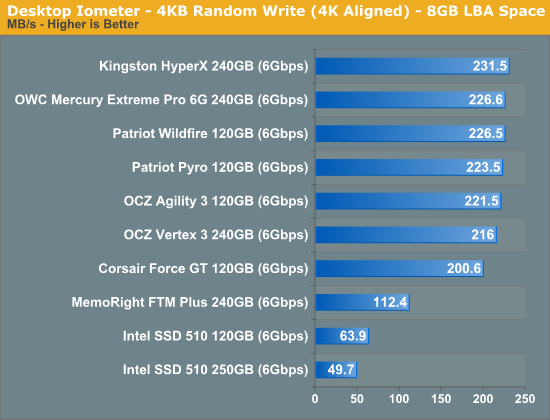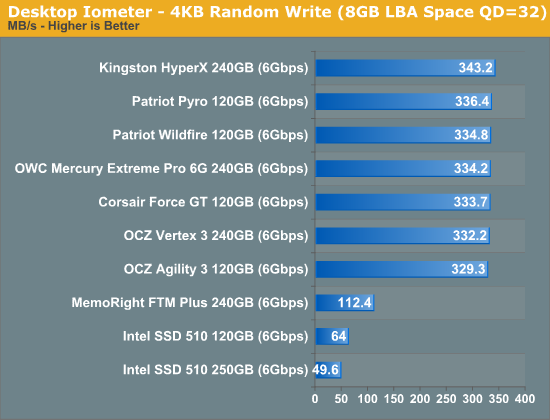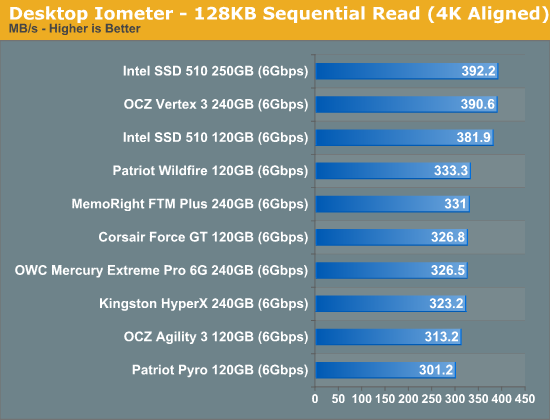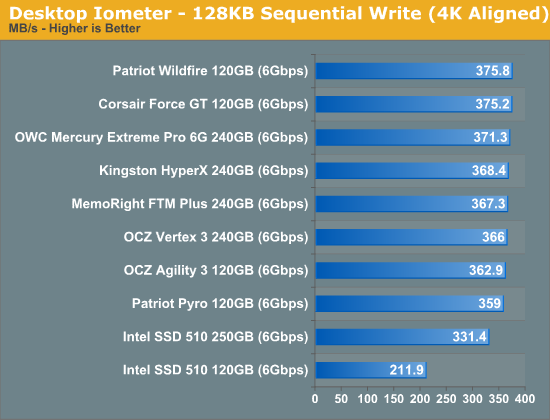The SandForce Roundup: Corsair, Kingston, Patriot, OCZ, OWC & MemoRight SSDs Compared
by Anand Lal Shimpi on August 11, 2011 12:01 AM ESTRandom Read/Write Speed
The four corners of SSD performance are as follows: random read, random write, sequential read and sequential write speed. Random accesses are generally small in size, while sequential accesses tend to be larger and thus we have the four Iometer tests we use in all of our reviews.
Our first test writes 4KB in a completely random pattern over an 8GB space of the drive to simulate the sort of random access that you'd see on an OS drive (even this is more stressful than a normal desktop user would see). I perform three concurrent IOs and run the test for 3 minutes. The results reported are in average MB/s over the entire time. We use both standard pseudo randomly generated data for each write as well as fully random data to show you both the maximum and minimum performance offered by SandForce based drives in these tests. The average performance of SF drives will likely be somewhere in between the two values for each drive you see in the graphs. For an understanding of why this matters, read our original SandForce article.

Random read performance is pretty consistent across all of the SF-2281 drives. The Patriot drives lose a bit of performance thanks to their choice in NAND (asynchronous IMFT in the case of the Pyro and Toggle NAND in the case of the Wildfire).

Most random writes are highly compressible and thus all of the SF-2281 drives do very well here. There's no real advantage to synchronous vs. asynchronous NAND here since most of the writes never make it to NAND in the first place. The Agility 3 and Vertex 3 here both use their original firmware while the newer drives are running the latest firmware updates from SandForce. The result is a slight gain in performance, but all things equal you won't see a difference in performance between these drives.
The MemoRight FTM Plus is the only exception here. Its firmware caps peak random write performance over an extended period of time. This is a trick you may remember from the SF-1200 days. It's almost entirely gone from the SF-2281 drives we've reviewed. The performance cap here will almost never surface in real world performance. Based on what we've seen, if you can sustain more than 50MB/s in random writes you're golden for desktop workloads. The advantage SandForce drives have is they tend to maintain these performance levels better than other controllers thanks to their real-time compression/dedupe logic.
Many of you have asked for random write performance at higher queue depths. What I have below is our 4KB random write test performed at a queue depth of 32 instead of 3. While the vast majority of desktop usage models experience queue depths of 0 - 5, higher depths are possible in heavy I/O (and multi-user) workloads:

All of the SF-2281 drives do better with a heavier load. The MemoRight drive is still capped at around 112MB/s here.
Sequential Read/Write Speed
To measure sequential performance I ran a 1 minute long 128KB sequential test over the entire span of the drive at a queue depth of 1. The results reported are in average MB/s over the entire test length.

The older SF-2281 firmwares did a bit better in some tests than the newer versions, hence the Vertex 3 being at the top here. All of the newer drives perform pretty similarly in our sequential read test.

The same goes for our sequential write test - all of the SF-2281 drives perform very similarly.










90 Comments
View All Comments
DarkKnight_Y2K - Thursday, August 11, 2011 - link
"Bottom line, it seems like sandforce-driven ssds have the biggest number of issues, yet you still recommend them."Did you read the last sentence of Anand's review?
"The safest route without sacrificing significant performance continues to be Intel's SSD 510."
Socratic - Thursday, August 11, 2011 - link
Yeah I don't know what planet you have been living on, but in MULTIPLE articles Anand has basically ended with the phase, The only logical choice is Intel.How is that being a sandforce fanboy??
You need to keep YOUR bias in line and re-read the article and past articles!!
Anand Lal Shimpi - Thursday, August 11, 2011 - link
Given the continued issues with SF drives I'm quickly looking at other alternatives. Toshiba and Crucial have never been top end performers, which is why I've focused most of my recommendations on the Intel SSD 510. The biggest advantage SandForce continues to have is in better performance over the long run thanks to its live dedupe/compression. I've been working on a way to quantify that for a while unfortunately I don't have a good test I'm happy with...yet.Going forward I believe Samsung may be a bigger player. Take note of the recently announced PM830, expect full coverage of that drive upon its arrival.
http://www.anandtech.com/show/4606/samsung-announc...
Take care,
Anand
melgross - Thursday, August 11, 2011 - link
Well, dedup itself is subject to a lot of controversy. It isn't necessarally a good thing.Anand Lal Shimpi - Thursday, August 11, 2011 - link
I'd argue for most mainstream uses it's a very good thing for long term performance. If the SF-2281 had Intel's track record it'd be the best option in my mind.Take care,
Anand
name99 - Thursday, August 11, 2011 - link
Hi Anand,Rather than beating up on you for not stressing reliability more in the past, I'm going to ask, AGAIN, that you take power more seriously.
My experience has been
- replaced the hard drive in my 2nd gen MacBook Air with a RunCore IV. The thing would crash about once a week, as far as I could tell NOT from logic errors but because its power draw during a long train of writes spiked higher than the interface was specced for. If this coincided with a high power draw elsewhere in the system --- fan, CPU etc, game over
- an OCZ enyo USB3 drive which work just fine as a READ drive --- and is once again somewhat flaky if too many back-to-back writes occur
- a Kingston SSDNow V which I have as the boot/VM drive for my iMac running off USB. My original plan for this was to have it running off FW800 (which is in theory 7W of power), but I got the same thing as the two previous drives --- crashes with too many back to back writes. It's now running successfully because I stuck it in a Kingwin USB<->SATA bridge that is for 3.5" drives, and thus has a separate power supply and the ability to provide a lot of juice.
All this basically mirrors (along a different dimension) what you have said: these drives are ABSOLUTE CRAP for the naive consumer. You buy them, things seem great, and then randomly and with no obvious pattern to the naive user, your system hangs.
You seem to be trying really hard to have the manufacturers get their act together; my point is to remind you that an IMPORTANT part of getting their act together is that these things are ALWAYS within spec with respect to power. Right now, we seem to have a lot (at least three different brands, in three different market segments) of drives that are simply not within spec --- they can run on the power that the system is specced to deliver for most command sequences, but there are always those few command sequences that over-draw power. Heck, at the very least, it is the responsibly of the drive to recognize this
situation and throttle themselves, just like any modern x86 CPU.
Coup27 - Thursday, August 11, 2011 - link
+1.I have been feeling similar sentiments lately as well.
I have posted in the forums on what happened to the 470 review but no official comment from anybody. Considering all of the reliability issues flying about, you woud think that if the 470 was a reliable as word suggests, it would have had a featured review.
Some guy actually bought an Agility 3 based off the AT review and forum list of recommended drives and neither mentioned the BSOD. When he got it the BSOD, he went into the forums and kicked off. Rightly so.
Unfortunately issues drag on for sometimes months before AT even update their article to make people aware that the product they might be buying could be seriously flawed.
No other website offers the depth of detail which AT does and for that the editors are applauded, but unfortunately the playing field does not seem level.
Lord 666 - Thursday, August 11, 2011 - link
Before this article, previous reviews of Vertex problems did not address the issues. This hits it head on.jo-82 - Thursday, August 11, 2011 - link
The Kingston HyperX cleary stands out with a consistent high performance. Why no words on that? Clearly the drive to buy. And Kingston has imho a much higher reputation on circuitry reliance and better QA in general then the rest of the pack, except Intel.Roland00Address - Thursday, August 11, 2011 - link
And I ain't sure you can apply the logic of Kingston being rocking when Kingston purposefully makes their SSD line confusing using similar names with completely different controllersKingston E series, Intel X25-E controller
Kingston M series, Intel X25-M G2 controller
SSDNow V 100, JMicron JMF618 controller
SSDNow V+, Samsung S3C29RBB01 controller
SSDNow V+ 100, Toshiba T6UG1XBG controller
SSDNow V+ 180, Toshiba T6UG1XBG controller
SSDNow V Series, Toshiba TC58NCF602GAT controller, which is based off the stuttering JMicron JMF602
30GB SSDNow V Series Boot Drive, Toshiba T6UG1XBG controller
I may be forgetting to list a couple models, but as I pointed above, Kingston has used 2 different controllers from Intel, 1 from Samsung, and 2 different from Toshiba (and all these controllers have similar names), not counting their most recent drive that is a Sandforce controller.